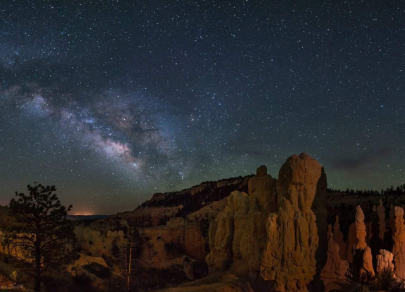
Top 5 locations for stargazing
Astrotourism is becoming more popular every year. People are willing to travel thousands of kilometers to admire the stars. But which places on Earth are considered the best for this? Let's find out now!




Lotus Temple
The Lotus Temple was constructed in New Delhi, India, from 1978 to 1986 according to the design by architect Fariborz Sahba. It embodies the image of the sacred lotus flower, symbolizing purity, strength, and the unity of all religions. The building, devoid of straight lines and angles, consists of 27 concrete petals clad in white Pentelic marble. Above, it resembles a giant lotus flower blooming against a backdrop of water. To create this effect, nine pools were built around the temple.

Shanghai Astronomical Museum
The largest astronomy-themed museum complex on the planet was opened three years ago in Shanghai as a branch of the local Museum of Science and Technology. The structure's architecture is a unique blend of abstract forms and smooth curves, reflecting the elusive and mysterious nature of the universe. Observing the building from above, one can see a complex composition reminiscent of planetary orbits and astronomical paths.

Central Academic Theater of the Russian Army
The Central Academic Theater of the Russian Army, formerly known as the Soviet Army Theater, was opened in the early 1930s and initially functioned solely as a touring institution, presenting performances in military units across the country. The theater acquired its own building in Moscow just before the Great Patriotic War. The structure was built in the shape of a five-pointed star, easily recognizable from a bird's-eye view.

Kunsthaus Museum of Contemporary Art
The Kunsthaus Museum of Contemporary Art, located in Graz, Austria, was built in 2003. The building's design follows the postmodernist style of blobitecture, characterized by curved and rounded forms. Due to its unusual exterior, locals have nicknamed this museum "the alien." From above, the building also has an unconventional shape, resembling a water droplet.

United Nations Headquarters
In 2012, a new United Nations office, UN City, was opened in the port area of Copenhagen. The complex's building was constructed in the shape of an eight-pointed star to provide functional accommodation for various UN departments, each having its wing. However, when viewed from above, many see not a star but a snowflake with eight rays, symbolizing the cold beauty of this northern city.

Maslennikov Factory Kitchen
This building was constructed in Samara, Russia, in the 1930s under the direction of architect Ekaterina Maksimova. Initially built in the constructivist style, the building served as a kitchen block for a military equipment factory. However, this year, it is planned to open a regional branch of the Tretyakov Gallery. Interestingly, the building has the shape of the main state emblem of the Soviet Union – the hammer and sickle – which is clearly visible from a bird's-eye view.

New Alexandria Library
This library, located on the shore of the Mediterranean Sea in Egypt, was built in 2002 on the site of the ancient Library of Alexandria. The building features unique architecture, including walls made of Aswan granite engraved with symbols from 120 scripts, and a 32-meter glass roof sloping toward the sea. The upper part of the structure is shaped like a sun disk, which can be observed when viewed from above.

Astrotourism is becoming more popular every year. People are willing to travel thousands of kilometers to admire the stars. But which places on Earth are considered the best for this? Let's find out now!